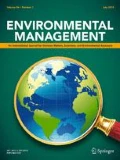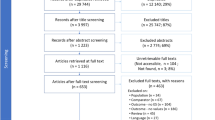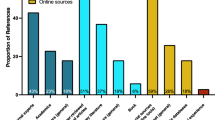Abstract
Collaborative environmental management draws on a wide range of information, from a variety of stakeholders, to inform policy. Scientific information is particularly relevant for ecosystem restoration plans, such as those created for recovering species on the brink of extinction. This study examines use of evidence in salmon recovery plans in Puget Sound, USA. Across 12 plans, coders characterized 1104 references to identify their source, recency, domain, and context. Subsequently, 11 plans were analyzed in-depth to identify how each reference was used to support particular kinds of claims. Results indicate the most frequent source of information cited in salmon recovery plans is government agencies, especially from national and state governments, followed by peer reviewed journal articles and scientific books. Journal articles come predominantly from high impact (top quartile) journals, although these articles are on average 15 years old. Sources are almost exclusively from the domain of natural sciences (97%), with just 1% social sciences and 2% non-scientific. More references come from beyond than within the local watershed. Different reference sources are used to support different kinds of claims, with government agency sources positively associated with claims about species status/trends, and peer reviewed journal articles positively associated with claims about causes of species decline. Overall, the lack of social science references, and lack of references to support claims about levels of community support, reduce managers’ abilities to incorporate features of social systems into species recovery planning.


Similar content being viewed by others
References
Addison PFE, Flander LB, Cook CN (2015) Are we missing the boat? current uses of long-term biological monitoring data in the evaluation and management of marine protected areas. J Environ Manag 149:148–156
Ager AA, Day MA, Waltz A, Nigrelli M, Vogler KC, Lata M (2021) Balancing ecological and economic objectives in restoration of fire-adapted forests: Case study from the Four Forest Restoration Initiative. Gen. Tech. Rep. RMRS-GTR-424. U.S. Department of Agriculture, Forest Service, Rocky Mountain Research Station, Fort Collins, CO, pp 30–https://doi.org/10.2737/RMRS-GTR-424
Bauer H, Nowell K, Sillero‐Zubiri C, Macdonald DW (2018) Lions in the modern arena of CITES. Conserv Lett 11(5):e12444
Bennett NJ, Roth R, Klain SC, Chan K, Christie P, Clark DA, Cullman G et al. (2017) Conservation social science: Understanding and integrating human dimensions to improve conservation. Biol Conserv 205(2017):93–108
Biden, J (2021) Memorandum on Restoring Trust in Government through Scientific Integrity and Evidence-Based Policymaking. President Biden’s Executive Order on “Restoring Trust in Government Through Scientific Integrity and Evidence-Based Policymaking”. Retrieved on June 1, 2022
Biedenweg K, Trimbach DJ, Fleming W (2021) Integrating social science in Puget Sound restoration. Ecol Restor 39(4):226–237. 2021
Blahna DJ, Kline JD, Williams DR, Rogers K, Miller AB, McCool SF, Valenzuela F (2020) Integrating social, ecological, and economic factors in sustainable recreation planning and decisionmaking. In: Selin Steven, Cerveny LeeK, Blahna DaleJ, Miller AnnaB (eds) Igniting research for outdoor recreation: linking science, policy, and action. Gen. Tech. Rep. PNW-GTR-987. US Department of Agriculture, Forest Service, Pacific Northwest Research Station, Portland, OR, 987, 173-188 257
Buhle ER, Scheuerell MD, Cooney TD, Ford MJ, Zabel RW, Thorson JT (2018) Using Integrated Population Models to Evaluate Fishery and Environmental Impacts on Pacific Salmon Viability. U.S. Department of Commerce, NOAA Technical Memorandum NMFS-NWFSC-140
Caplan N (1979) The two-communities theory and knowledge utilization. Am Behav Scientist 22(3):459–470
Carballo-Cárdenas EC, Mol APJ, Tobi H (2013) Information systems for marine protected areas: How do users interpret desirable data attributes? Environ Model Softw 41:185–198
Cash DW, Clark WC, Alcock F, Dickson NM, Eckley N, Guston DH, Jäger J, Mitchell RB (2003) Knowledge systems for sustainable development. Proc Natl Acad Sci USA 100:8086–8091. https://doi.org/10.1073/pnas.1231332100
Christensen J (2018) Economic knowledge and the scientization of policy advice. Policy Sci 51(3):291–311. https://doi.org/10.1007/s11077-018-9316
Clark WC, van Kerkhoff L, Lebel L, Gallopin GC (2016) Crafting usable knowledge for sustainable development. Proc Natl Acad Sci 113:4570–4578. https://doi.org/10.1073/pnas.1601266113
Colavito MM (2017) The role of science in the collaborative forest landscape restoration program. J Forestry 115(1):34–42
Costa M, Desmarais BA, Hird JA (2016) Science use in regulatory impact analysis: The effects of political attention and controversy. Rev Policy Res 33(3):251–269.
Cowling RM, Egoh B, Knight AT, O’Farrell PJ, Reyers B, Rouget M, Roux DJ, Welz A, Wilhelm-Rechman A (2008) An operational model for mainstreaming ecosystem services for implementation. Proc Natl Acad Sci USA 105:9455–9456
Cvitanovic C, Fulton CJ, Wilson SK, van Kerkhoff L, Cripps IL, Muthiga N (2014) Utility of primary scientific literature to environmental managers: an international case study on coral-dominated marine protected areas. Ocean Coast Manag 102:72–78
Cvitanovic C, Hobday AJ, van Kerkhoff L, Wilson SK, Dobbs K, Marshall NA (2015) Improving knowledge exchange among scientists and decision-makers to facilitate the adaptive governance of marine resources: a review of knowledge and research needs. Ocean Coast Manag 112:25–35
Dee Boersma P, Kareiva P, Fagan WF, Clark JA, Hoekstra JM (2001) How good are endangered species recovery plans? The effectiveness of recovery plans for endangered species can be improved through incorporation of dynamic, explicit science in the recovery process, such as strongly linking species’ biology to recovery criteria. BioScience 51(8):643–649.
Desmarais BA, Hird JA (2014) Public policy’s bibliography: The use of research in US regulatory impact analyses (2014). Regul Gov 8(4):497–510
Evans D, Demeter A, Gajdoš P, Halada L (2013) Adapting environmental conservation legislation for an enlarged European Union: experience from the Habitats Directive. Environ Conserv 40(2):97–107
Farwig N, Ammer C, Annighöfer P, Baur B, Behringer D, Diekötter T, Hotes S, Leyer I, Müller J, Peter F, Riecken U (2017) Bridging science and practice in conservation: Deficits and challenges from a research perspective. Basic Appl Ecol 24:1–8
Floress K, Akamani K, Halvorsen KE, Kozich AT, Davenport M (2015) The role of social science in successfully implementing watershed management strategies. J Contemp Water Res Educ 154 1:85–105
Ford AT, Ali AH, Colla SR, Cooke SJ, Lamb CT, Pittman J, Shiffman DS, Singh NJ (2021) Understanding and avoiding misplaced efforts in conservation. FACETS 6:252–271. https://doi.org/10.1139/facets-2020-0058
Francis TB, Whittaker KA, Shandas V, Mills AV, Graybill JK (2005) Incorporating science into the environmental policy process: a case study from Washington State. Ecology Soc 10, 1:35–51
Groves CR, Jensen DB, Valutis LL, Redford KH, Shaffer ML, Scott JM, Baumgartner JV, Higgins JV, Beck MW, Anderson MG (2002) Planning for Biodiversity Conservation: Putting Conservation Science into Practice. BioScience 52(6):499–512
Guerrero AM, Bennett NJ, Wilson KA, Carter N, Gill D, Mills M, Ives CD, et al. (2018) Achieving the promise of integration in social-ecological research. Ecology and Society 23, 3
Heikkila T, Gerlak AK (2005) The formation of large‐scale collaborative resource management institutions: Clarifying the roles of stakeholders, science, and institutions. Policy Stud J 33(4):583–612.
Innes J, Booher D (2010) Planning with Complexity: An introduction to collaborative rationality for public policy. Routledge, New York
Kadykalo AN, Buxton RT, Morrison P, Anderson CM, Bickerton H, Francis CM, Fahrig L (2021) Bridging research and practice in conservation. Conserv Biol 35(6):1725–1737
Kareiva P, Andelman S, Doak D, Elderd B, Groom M, Hoekstra J, Hood L, James F, Lamoreux J, LeBuhn G, McCulloch C, Regetz J, Savage L, Ruckelshaus M, Skelly D, Wilbur H, Zamudio K (1999) Using Science in Habitat Conservation Plans. National Center for Ecological Analysis and Synthesis, University of California, Santa Barbara
King G, Keohane RO, Verba S (1994) Designing social inquiry: Scientific inference in qualitative research. Princeton University Press
Koontz TM, Steelman TA, Carmin J, S Korfmacher K, Moseley C, Thomas CW (2004) Collaborative Environmental Management: What Roles for Government? Resources for the Future Press, Washington, D.C
Koontz TM, Thomas C (2018) Use of science in collaborative environmental management: evidence from local watershed partnerships in the Puget Sound. Environ Sci Policy 88:17–23
Koontz TM, Thomas C, Sell A (2018) Science and Collaborative Watershed Partnerships: Who, What, When, and How. Midwest Political Science Association annual meeting, Chicago, April
Koontz TM (2019) The science-policy nexus in collaborative governance: Knowledge use in ecosystem recovery efforts. Rev Policy Res 36(6):708–735. https://doi.org/10.1111/ropr.12362
Korfmacher KS, Koontz TM (2003) Collaboration, information, and preservation: The role of expertise in farmland preservation task forces. Policy Sci 36:213–236
Krippenodorff K (2013) Content analysis: an introduction to its methodology, Los Angeles. SAGE, London
Kuckartz U (2014) Quantitative Text Analysis: A Guide to Methods, Practice, and Using Software. Sage Publications, Los Angeles
Landry R, Amara N, Lamari M (2001) Climbing the ladder of research utilization: Evidence from social science research. Sci Commun 22:396–422
Lemos MC, Morehouse BJ (2005) The co-production of science and policy in integrated climate assessments. Glob Environ Change 15:57–68
Leslie HM, McLeod KL (2007) Confronting the challenges of implementing marine ecosystem‐based management. Front Ecol Environ 5 10:540–548
Letey J (1999) Science and policy in integrated watershed management: A case study. JAWRA J Am Water Resour Assoc 35(3):603–607.
Machen R (2018) Towards a critical politics of translation:(Re) Producing hegemonic climate governance. Environ Plan E: Nat Space 1(4):494–515
MacDonald BH, Soomai SS, De Santo EM, Wells PG (2016) In MacDonald B, Soomai S, De Santo E, Wells P (Eds). Science, information, and policy interface for effective coastal and ocean management. Taylor & Francis, Boca Raton, pp. 19–43
Mapes L (2019) After 20 years and $1 billion spent on Washington state salmon programs, fish still declining, new report says. Seattle Times, January 17
McKinley E, Acott T, Yates KL (2020) Marine social sciences: Looking towards a sustainable future. Environ Sci Policy 108:85–92.
McNie EC (2007) Reconciling the supply of scientific information with user demands: an analysis of the problem and review of the literature. Environ Sci policy 10(1):17–38
Mooers AO, Doak DF, Findlay CS, Green DM, Grouios C, Manne LL, Rashvand A, Rudd MA, Whitton J (2010) Science, policy, and species at risk in Canada. BioScience 60(10):843–849
Muro M, Jeffrey P (2012) Time to talk? How the structure of dialog processes shape stakeholder learning in participatory water resources management. Ecol Soc 17(1):3. https://doi.org/10.5751/ES-04476-170103
Newig J, Kochskämper E, Challies E, Jager NW (2016) Exploring governance learning: How policymakers draw on evidence, experience and intuition in designing participatory flood risk planning. Environ Sci Policy 55(2016):353–360
NOAA (National Oceanic and Atmospheric Administration) (no date) CSTAR Projects. Office of Science and Technology Integration https://vlab.noaa.gov/web/nws-osti/cstar
Norström AV, Cvitanovic C, Löf MF, West S, Wyborn C, Balvanera P, et al. Principles for knowledge co-production in sustainability research. Nat. Sustain. (2020), https://doi.org/10.1038/s41893-019-0448-2
NSF (National Science Foundation) (2022) NSF Invests in use-inspired climate change and clean energy research. NSF News, September 9. https://beta.nsf.gov/news/nsf-invests-use-inspired-climate-change-clean
O’Connor RA, Nel JL, Roux DJ, Leach J, Lim-Camacho L, Medvecky F, van Kerkhoff L, Raman S (2021) The role of environmental managers in knowledge co-production: Insights from two case studies. Environ Sci Policy 116:188–195. https://doi.org/10.1016/j.envsci.2020.12.001
Obama B (2009) Inaugural Address. https://obamawhitehouse.archives.gov/blog/2009/01/21/president-barack-obamas-inaugural-address. Retrieved on 1 June 2022
Ostrom E (1990) Governing the commons: The evolution of institutions for collective action. Cambridge University Press
Ouimet M, Landry R, Ziam S, Bédard PO (2009) The absorption of research knowledge by public civil servants. Evidence & Policy: A Journal of Research. Debate Pract 5(4):331–350
Pattyn V, Gouglas A, De Leeuwe J (2020) The knowledge behind Brexit. A bibliographic analysis of ex-ante policy appraisals on Brexit in the United Kingdom and the European Union. J Eur Public Policy 2020:1–19
Piczak ML, Kadykalo AN, Cooke SJ, Young N (2021) Natural resource managers use and value Western-based science, but barriers to access persist. Environ Manag: 1–14
Pullin AS, Knight TM (2003) Support for decision making in conservation practice: an evidence-based approach. J Nat Conserv 11:83–90
Puget Sound Partnership (No date) About the Partnership https://www.psp.wa.gov/puget-sound-partnership.php accessed 5/12/20
Rahn ME, Doremus H, Diffendorfer J (2006) Species coverage in multispecies habitat conservation plans: where’s the science? BioScience 56(7):613–619
Raymond CM, Fazey I, Reed MS, Stringer LC, Robinson GM, Evely AC (2010) Integrating local and scientific knowledge for environmental management. J Environ Manag 91:1766–1777
Robinson P, Genskow K, Shaw B, Shepard R (2012) Barriers and opportunities for integrating social science into natural resource management: lessons from national estuarine research reserves. Environ Manag 50(6):998–1011
Ross JD, Breeze H (2016) What do users want from a state of the environment report? A case study of awareness and use of Canada’s State of the Scotian Shelf Report. In: MacDonald B, Soomai S, De Santo E, Wells P (Eds) Science, information, and policy interface for effective coastal and ocean management. Taylor & Francis, Boca Raton, p 283–302
Roux DJ, Rogers KH, Biggs HC, Ashton PJ, Sergeant A (2006) Bridging the science-management divide: moving from unidirectional knowledge transfer to knowledge interfacing and sharing. Ecol Soc 11(1):4, http://www.ecologyandsociety.org/vol11/iss1/art4/
Safford HD, Sawyer SC, Kocher SD, Hiers JK, Cross M (2017) Linking knowledge to action: the role of boundary spanners in translating ecology. Front Ecol Environ 15(10):560–568
Safford TG, Norman KC (2011) Water water everywhere, but not enough for salmon? Organizing integrated water and fisheries management in Puget Sound. J Environ Manag 92(3):838–847
Salafsky N, Boshoven J, Burivalova Z, Dubois NS, Gomez A, Johnson A et al. (2019) Defining and using evidence in conservation practice. Conserv Sci Pr 1:e27. https://doi.org/10.1111/csp2.27
Scott TA, Carter DP (2019) Collaborative governance or private policy making? When consultants matter more than participation in collaborative environmental planning. J Environ Policy Plan 21(2):153–173
Soomai SS (2016) Measuring Awareness, Use, and Influence in Information: Where Theory Meets Practice. In: MacDonald B, Soomai S, De Santo E, Wells P (Eds) Science, information, and policy interface for effective coastal and ocean management. Taylor & Francis, Boca Raton, p 253–279
Turnhout E, Metze T, Wyborn C, Klenk N, Louder E (2020) The politics of co-production: participation, power, and transformation. Curr Opin Environ Sustainability 42:15–21. https://doi.org/10.1016/j.cosust.2019.11.009
Ulibarri N (2015) Tracing process to performance of collaborative governance: A comparative case study of federal hydropower licensing. Policy Stud J 43(2):283–308
Ulibarri N, Emerson K, Imperial MT, Jager NW, Newig J, Weber E (2020) How does collaborative governance evolve? Insights from a medium-n case comparison. Policy Soc 39(4):617–637
United Nations Scientific Advisory Board (2016) The Future of Scientific Advice to the United Nations. UNESCO https://unesdoc.unesco.org/ark:/48223/pf0000245801. Accessed 10/23/2022
United Nations Educational, Scientific, and Cultural Organization (UNESCO) (2021) Science and the Pandemic. UNESCO Science Report 2021. https://www.unesco.org/reports/science/2021/en/science-pandemic. Accessed 10/28/2022
Walsh JC, Dicks LV, Raymond CM, Sutherland WJ (2019) A typology of barriers and enablers of scientific evidence use in conservation practice. J Environ Manag 250:109481. https://doi.org/10.1016/j.jenvman.2019.109481
WDFW Washington Department of Fish and Wildlife. No date. “Harvest – Overview: Role in Recovery.” https://fortress.wa.gov/dfw/score/score/harvest/harvest.jsp visited 4/15/22
Washington State Recreation and Conservation Office. No date. “Lead Entities: Salmon Recovery Done Locally.”. https://rco.wa.gov/salmon-recovery/managing-organizations/lead-entities/. Accessed 11/4/22
Weiss CH (1979) The many meanings of research utilization. Public Adm Rev 29:426–431
Williams DB (2021) Homewaters: A Human and Natural History of Puget Sound. University of Washington Press, Seattle
Young N, Gingras I, Nguyen VM, Cooke SJ, Hinch SG (2013) Mobilizing new science into management practice: the challenge of biotelemetry for fisheries management, a case study of Canada’s Fraser River. J Int Wildl Law Policy 16:328–348. https://doi.org/10.1080/13880292.2013.805074
Zhang G, Ding Y, Milojević S (2013) Citation content analysis (CCA): A framework for syntactic and semantic analysis of citation content. J Am Soc Inf Sci Technol 64(7):1490–1503
Acknowledgements
Research assistants on this project included Mason Ward, Johannah Noyes, Amanda Davis, Lexi Ehresmann, Joshua Murray, Myah Pacheco, and Clare Tupper. Funding for student interns provided by the Center for Urban Waters in Tacoma, WA.
Author information
Authors and Affiliations
Corresponding author
Ethics declarations
Conflict of Interest
The author declares no competing interests.
Additional information
Publisher’s note Springer Nature remains neutral with regard to jurisdictional claims in published maps and institutional affiliations.
Supplementary information
Rights and permissions
Springer Nature or its licensor (e.g. a society or other partner) holds exclusive rights to this article under a publishing agreement with the author(s) or other rightsholder(s); author self-archiving of the accepted manuscript version of this article is solely governed by the terms of such publishing agreement and applicable law.
About this article
Cite this article
Koontz, T.M. Incorporating Evidence into Collaborative Ecosystem Restoration: A Content Analysis of Bibliographic References and their Use in Salmon Recovery Plans. Environmental Management 71, 350–364 (2023). https://doi.org/10.1007/s00267-022-01766-w
Received:
Accepted:
Published:
Issue Date:
DOI: https://doi.org/10.1007/s00267-022-01766-w




